The man who created The Kelpies
- Published
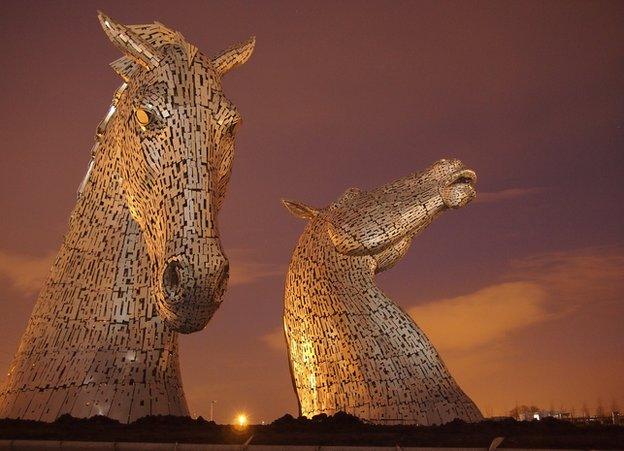
For the past eight years, Glaswegian sculptor Andy Scott has been working on the biggest project of his life. The Kelpies are two 30m-tall horse heads made of steel, now standing alongside the Forth and Clyde Canal near Falkirk.
They started off as a drawing on his Dutch girlfriend's kitchen table in Amsterdam and after eight "tortuous" years they are finally built and open to the public.
The £5m Kelpies are the centrepiece of the 740-acre Helix Park, which has been built on reclaimed scrubland between Falkirk and Grangemouth and they are already becoming one of Scotland's most photographed landmarks.
Scott hopes they can become Scotland's answer to Antony Gormley's Angel of the North which stands 20m (66ft) high on a hill above Gateshead.
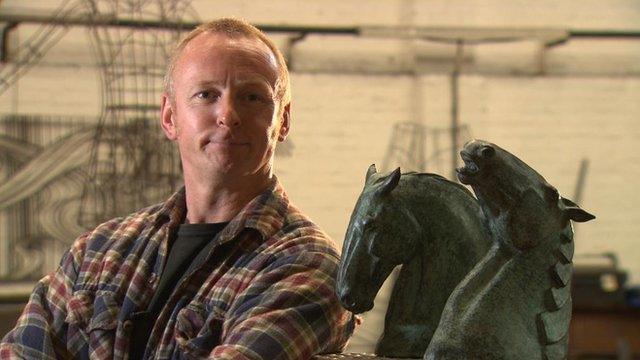
Andy Scott has been working on the project for eight years
The Glaswegian artist's sculptures, which each consist of 300 tonnes of steel, are 10m taller than Gormley's, and he hopes they will bring the same level of attention to an often neglected part of Scotland that the Angel has to Tyneside.
"I can't tell you the blood, sweat and tears I've put into it," he says.
"I'd love to see them become well-known and recognised internationally as well as in Scotland and the UK."
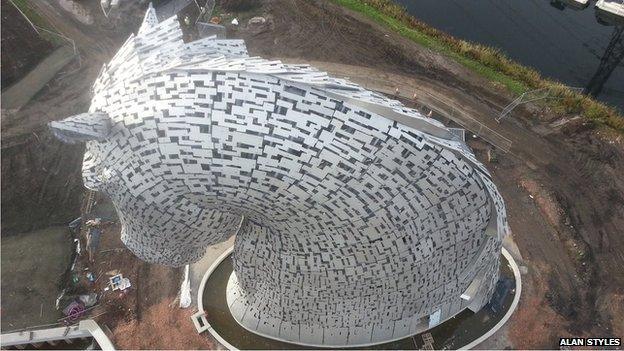
Alan Styles, who worked on the project, captured this view from 41m (135ft) in the air on a cherry-picker
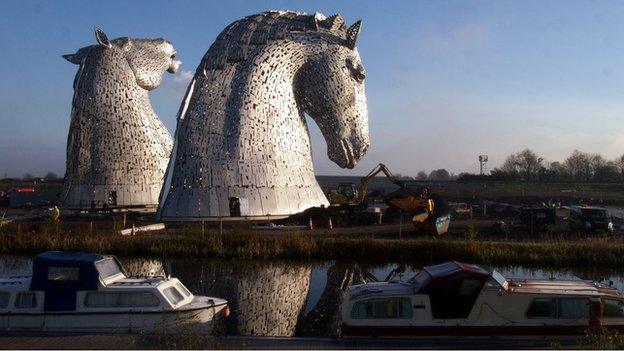
The Kelpies are one of the UK's tallest pieces of public art
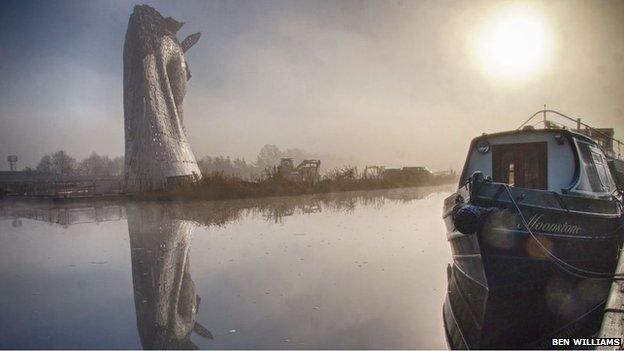
The Kelpies are visible from the M9 motorway, as well as the nearby canal
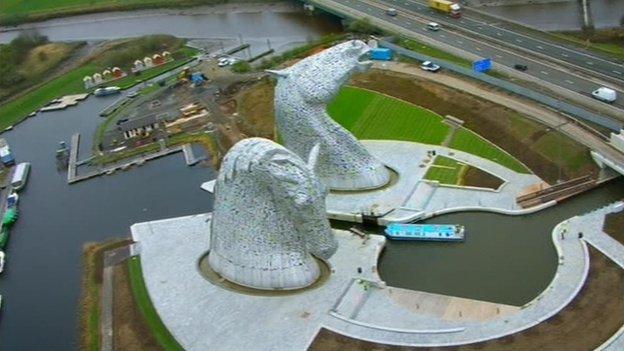
The Kelpies are sited at the eastern entrance to the Forth and Clyde canal
Scott adds: "The London art world controls the world. You can do what you like up here but to get any recognition for your works is very difficult.
"I'm hoping that these can do that and give Scotland something the whole population can be proud of."
The Kelpies are named after the mythical water horses said to be in Scottish lochs and rivers.
However, Scott says the inspiration for his sculptures comes from the heavy horses that once powered Scotland's canals.
His giant horses' heads form a new gateway into the canal system of central Scotland from the Forth estuary via the River Carron.
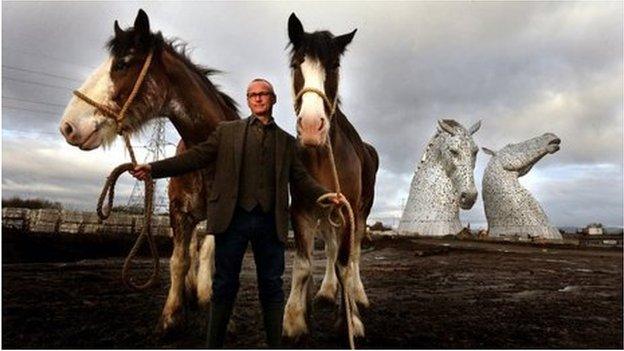
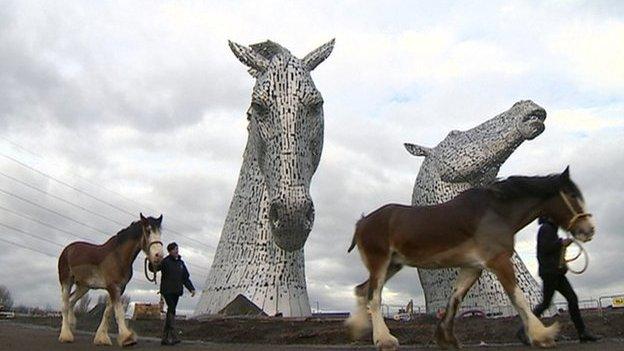
Clydesdale horses are the inspiration for the Kelpies
Scott hopes that people can sail in from Europe or elsewhere in Britain and the first thing they will see are his colossal Kelpies.
The 50-year-old artist studied at Glasgow School of Art in the 1980s, a time when he says "there wasn't such a thing as public art as we know it".
He says he would have "bitten your hand off" for the chance to do a project like this.
Scott now has large public art sculptures all over Scotland and around the world in places such as London, Sydney and Dubai.
But the work that started it all off for him was the Heavy Horse which was placed beside the M8 east of Glasgow in 1997.
That horse was just 4.5m (14ft) tall, not much bigger than the 1/10th scale-model of the Kelpies which Scott began to make in his studio a decade later.
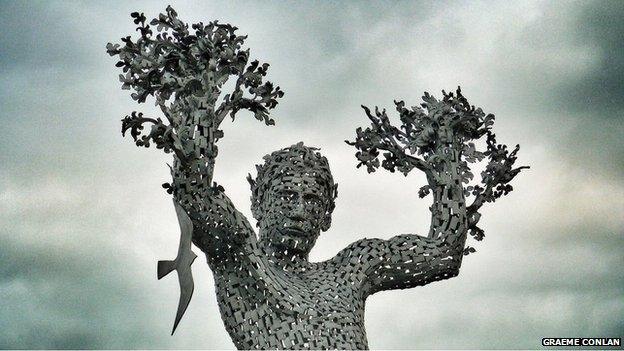
The Air Spirit statue in Tullibody is one of Scott's works
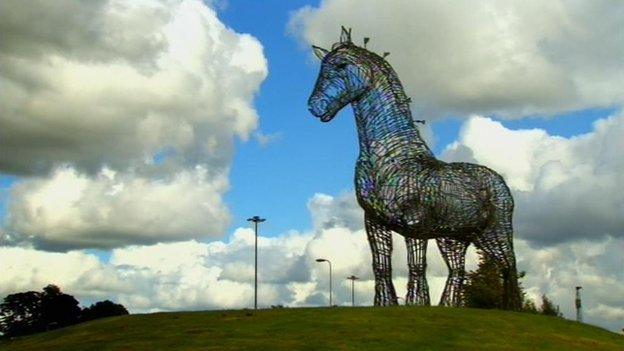
The Heavy Horse by the side of the M8 motorway was Scott's first major public art work
Scott's original Heavy Horse - modelled on one of Scotland's best-known work horses, the Clydesdale breed - was said to be emblematic of Glasgow's transformation from a city built on heavy industry and manufacturing into one known for exhibition centres and garden festivals, not to mention call centres and service industry jobs.
It went from a work horse to a show horse, as he puts it.
For the Kelpies he returned to the heavy horse theme to make reference to the beasts that used to draw barges along the canal systems.
He was also pleased to discover the story of Carnera, reputed to be the world's largest horse, which hauled delivery wagons around Falkirk in the 1930s for Barrs soft drinks company, creators of Irn-Bru.
When Scott began the Kelpie project the design was even more ambitious than the finished sculptures turned out.
A seven-minute film of time-lapse photography featuring Andy Scott's Kelpies is shown at New York Tartan Week
Originally, the Kelpies had been intended to be functional as well as aesthetic, operating a "displacement lock system" to provide boat access to the canal from the River Carron and ultimately the Forth and the North Sea.
One of the massive horse heads was to have rocked forward 5m (16ft) and the other was to have raised backwards by the same distance.
The water displaced by this movement was supposed to fill a central lock to lift the boats into the Forth and Clyde canal.
But, as the project dragged on, changes were made to move the figures further apart because of concerns over wind resistance.
Other safety concerns were raised and in June 2011 the boat lift plan was scrapped due to "very complex and fluctuating engineering challenges".
But despite its initial function being dropped the plan for the sculptures went ahead. It was also agreed that the public would be able to go inside the sculptures to witness them at close quarters.
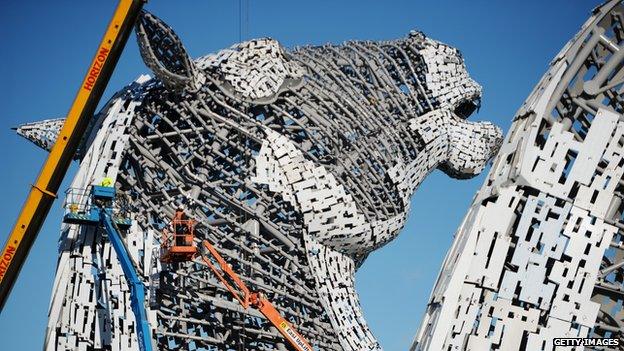
The Kelpies were put together on site in the summer and autumn of 2013
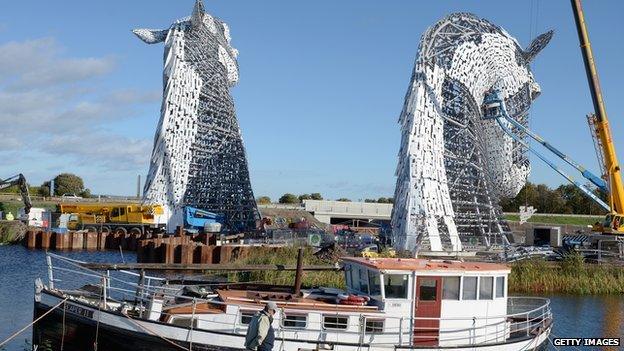
A massive construction process took 75 days for each head
Scrapping the boat lift was just one of numerous challenges to the project over the years.
Despite it winning lottery cash in November 2007, it was still threatened by the financial crash the following year and Scott admits to being "stung" by a article in the Scottish Sun at the time condemning the sculpture project as a "zany artwork" that was a waste of the public's cash.
As well as the political, bureaucratic and financial hurdles, there was also the small problem of how to make such huge structures.
Scott slowly realised that he was no longer an artist working alone but that he was part of an enormous team with a variety of expertise in fabrication and construction.
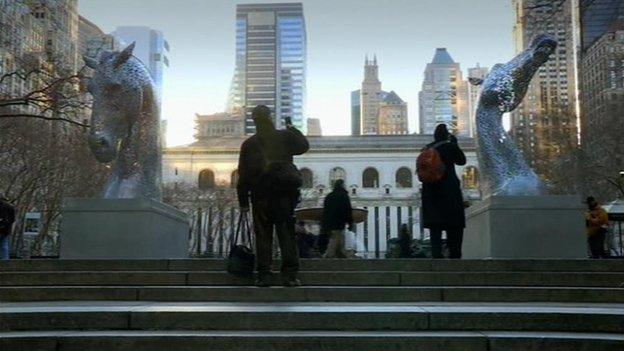
The Kelpie maquettes were a popular attraction in New York
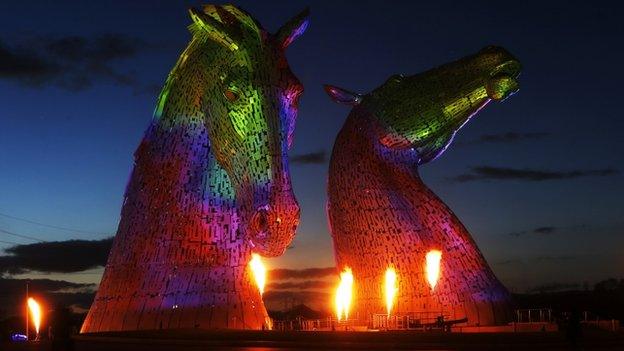
The Kelpies were lit up for a launch event
"Most of my work is hand-made and it is something I'm very proud of," Scott says.
"But at this scale I'm allowing that bit of separation, difficult as it is."
The design process involved Scott building maquettes - scale models - about one-tenth the size of the completed sculpture.
The first set was to test out the design and garner interest and the second was a more refined version that would form the basis of the finished work.

The Kelpie project was criticised in the early stages by the Sun newspaper
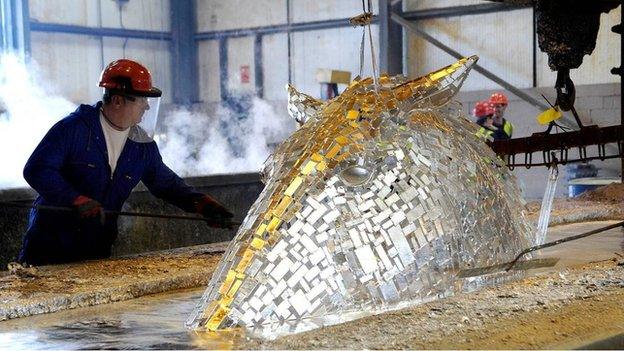
The Kelpies' heads were galvanised before their installation
The final 3m-tall (9ft) unpolished steel maquettes were dipped in a vat of zinc to galvanise them and protect against corrosion.
Like earlier versions each sculpture is made from hundreds of small, hand-cut steel plates welded on to a skeleton of steel bars.
In the later model Scott realigned the bars which make up the horses outer layer to make them run vertically in a bid to "accentuate the idea of movement".
The finished maquettes were then scanned to create a 3D computer model of the thousands of components that make up the Kelpies.
The method of construction bears remarkable similarities to shipbuilding.
Fabrication began in Yorkshire in September 2012 and soon "a vast Meccano set" began to emerge.
Scott took a back seat as the processes of scaling up his models took place and eventually the components arrived on site, which was prepared in advance with foundations more than 30m deep.
Each head took 75 days to construct as summer 2013 gave way to autumn and by spring 2014, the whole site was ready to welcome visitors.
The "agony" of an eight year project, which he often thought would never be completed, came to a close with a opening ceremony featuring a dramatic lighting display.
Scott can now take satisfaction in his giant sculptures but he has one last ambition for them.
He says: "I used to joke that my job would be done when these are the lair of a villain in a James Bond movie.
"Who knows what the future holds?"
Creating the Kelpies will be broadcast on BBC Two Scotland at 21:00 on Tuesday 6 May.
- Published21 April 2014
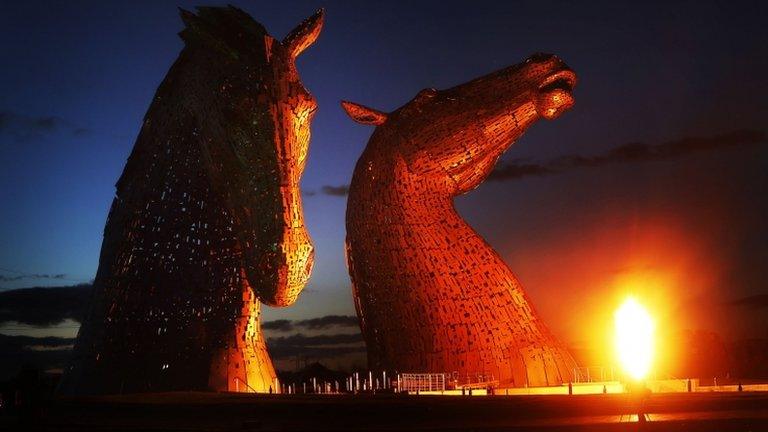
- Published27 November 2013
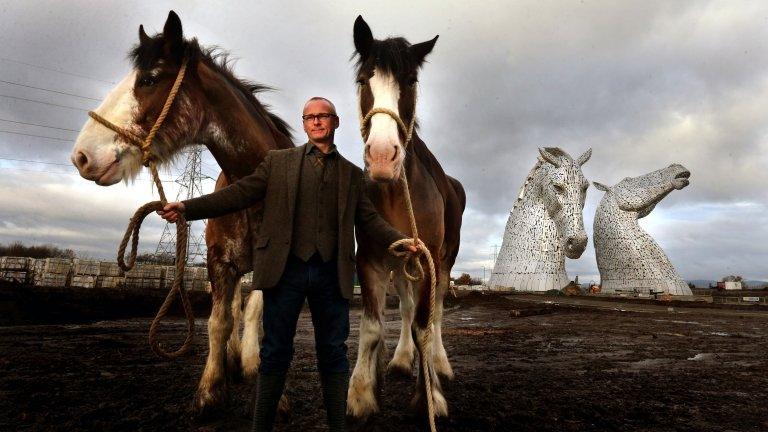
- Published27 November 2013
- Published29 May 2012
